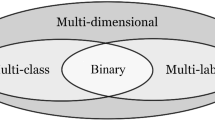Abstract
In this work, to construct classifiers for two linearly inseparable sets, the problem of minimizing the margin of incorrect classification is formulated, approaches to achieving approximate solution, and calculation estimates of the optimal value for this problem, are considered. Results of computational experiments that compare proposed approaches with SVM are presented. The problem of identifying informative features for large-dimensional diagnostic applications is analyzed and algorithms for its solution are developed.
Similar content being viewed by others
References
G. M. Fung and O. L. Mangasarian, “Multicategory proximal support vector machine classifiers,” Mach. Learn. 59, 77–97 (2005).
Chih-Wei Hsu and Chih-Jen Lin, “A comparison of methods for multiclass support vector machines,” IEEE Trans. Neural Networks 13 (2), 415–425 (2002).
J. C. Platt, N. Cristianini, and J. Shawe-Taylor, “Large margin DAG’s for multiclass classification,” in Advances in Neural Information Processing Systems (MIT Press, Cambridge, MA, 2000), Vol. 12, pp. 547–553.
Yu. Laptin, Yu. Zhuravlev, and A. Vinogradov, “A comparison of some approaches to classification problems, and possibilities to construct optimal solutions efficiently,” Pattern Recogn. Image Anal. 24 (2), 189–195 (2014).
T. G. Dietterich and G. Bakiri, “Solving multiclass learning problems via error-correcting output codes,” J. Artif. Intellig. Res. 2, 263–286 (1995).
C. Lemaréchal, “Lagrangian relaxation,” Comput. Combinat. Optimiz. 2241, 112–156 (2001).
L. Vanderberghe and S. Boyd, “Semidefinite programming,” Siam Rev., No. 38, 49–95 (1996).
N. Z. Shor, Nondifferentiable Optimization and Polynomial Problems (Kluwer Acad. Publ., Amsterdam, Dordrecht, London, 1998).
S. Kim, M. Kojima, and H. Waki, “Exploiting sparsity in SDP relaxation for sensor network localization,” SIAM J. Optimiz. 20 (1), 192–215 (2009).
O. A. Berezovskyi, “Exactness criteria for SDP-relaxations of quadratic extremum problems,” Cybernet. Syst. Anal. 52 (6), 915–920 (2016).
L. Vanderberghe and S. Boyd, “Semidefinite programming,” Siam Rev., No. 38, 49–95 (1996).
O. A. Berezovskyi, “On the accuracy of dual bounds for quadratic extremum problems,” Cybernet. Syst. Anal. 48 (1), 26–30 (2012).
V. V. Dmitrenko et al., “Determination of molecular glioblastoma subclasses on the basis of analysis of gene expression,” Cytol. Genet. 48 (6), 383–39 (2014).
Yu. Laptin, “Exact penalty functions and convex extensions of functions in schemes of decomposition in variables,” Cybernet. Syst. Anal. 52, 85–95 (2016).
N. Z. Shor and N. G. Zhurbenko, “A minimization method using the operation of extension of the space in the direction of the difference of two successive gradients,” Cybernet. Syst. Anal. 7 (3), 450–459 (1971).
Author information
Authors and Affiliations
Corresponding author
Additional information
The article is published in the original.
Yurii Ivanovich Zhuravlev. Born in Voronezh, 1935. In 1957, graduated from Moscow State University. Doctor of Physics and Mathematics since 1965, professor since 1967, academician of Russian Academy of Sciences since 1992. Deputy director of Dorodnicyn Computing Centre, Federal Research Centre ‘Computer Science and Control’ of Russian Academy of Sciences, chair of the Mathematics Department of Russian Academy of Sciences, head of the Chair of Moscow State University, editor in chief of International journal Pattern Recognition and Image Analysis. Foreign member of Spanish Royal Academy of Sciences, National Academy of Sciences of Ukraine, and European Academy of Sciences. Winner of Lenin and Lomonosov prizes. Main fields of scientific interest: mathematical logic; control systems theory; mathematical theory of pattern recognition, data analysis and forecasting; operations research; artificial intelligence. Developed new research areas: theory of local optimization algorithms, algorithms of estimate calculation, algebraic theory of recognition algorithms.
Yurii Petrovich Laptin. Born in 1951. Graduated from the Moscow Institute of Physics and Technology in 1974. Doctor of Physics and Mathematics since 2016. Senior Researcher at the Department of Methods of Nonsmooth Optimization at the Glushkov Institute of Cybernetics, National Academy of Sciences of Ukraine. Scientific interests: methods of mathematical programming and their applications. Author of 70 scientific papers.
Aleksandr Petrovich Vinogradov. Born in 1951. Graduated from the Moscow Institute of Physics and Technology in 1974. Candidate of Physics and Mathematics since 1978. Senior Researcher at Dorodnicyn Computing Centre, Federal Research Centre ‘Computer Science and Control’ of Russian Academy of Sciences. Scientific interests: algebraic and geometric methods in pattern recognition and image processing. Author of 70 scientific papers.
Oleg Anatol’evich Berezovskyi. Born in 1964. Graduated from the Moscow Institute of Physics and Technology in 1988. Candidate degree in mathematical cybernetics, 1995. Senior Researcher at the Department of Nonsmooth Optimization Methods, Glushkov Institute of Cybernetics, National Academy of Sciences of Ukraine. Scientific interests: optimization methods and their applications. Author of 50 scientific papers.
Nikolai Georgievich Zhurbenko. Born in 1946. Graduated from the Moscow Institute of Physics and Technology in 1970. Candidate of Physics and Mathematics since 1976. Senior Researcher at the Department of Methods of Nonsmooth Optimization at the Glushkov Institute of Cybernetics, National Academy of Sciences of Ukraine. Scientific interests: methods of mathematical programming and their applications. Author of 80 scientific papers.
Oleksii Petrovich Lykhovyd. Born in 1959. Graduated from Kyiv Polytechnical Institute in 1983. Presently, Scientific Researcher at the Department of Nonsmooth Optimization Methods, Glushkov Institute of Cybernetics, National Academy of Sciences of Ukraine. Scientific interests: optimization methods and their applications. Author of 48 scientific papers.
Rights and permissions
About this article
Cite this article
Zhuravlev, Y.I., Laptin, Y.P., Vinogradov, A.P. et al. Linear classifiers and selection of informative features. Pattern Recognit. Image Anal. 27, 426–432 (2017). https://doi.org/10.1134/S1054661817030336
Received:
Published:
Issue Date:
DOI: https://doi.org/10.1134/S1054661817030336




